The once sizzling market for multifamily properties in the Southeast and Southwest US has chilled, creating cracks in the capital stacks of owners—and possible opportunities for investors.
Many recent buyers and developers of Sunbelt multifamily properties are overleveraged and need capital to bridge the gap between their debt balances and the significantly depreciated equity value of their holdings. The current pall over the asset class, however, obscures its long-term attractiveness for patient investors.
THE ROUTE TO TODAY
How times have changed for the once-booming multifamily housing sector across the Sunbelt—the band of US states stretching from the Southeast to the Southwest.
The all-time high watermark for the sector came in the fourth quarter of 2021 when $97 billion in transactions took place, accounting for nearly a third of the nation’s multifamily property transactions—which themselves were more than double the previous quarterly record level.1
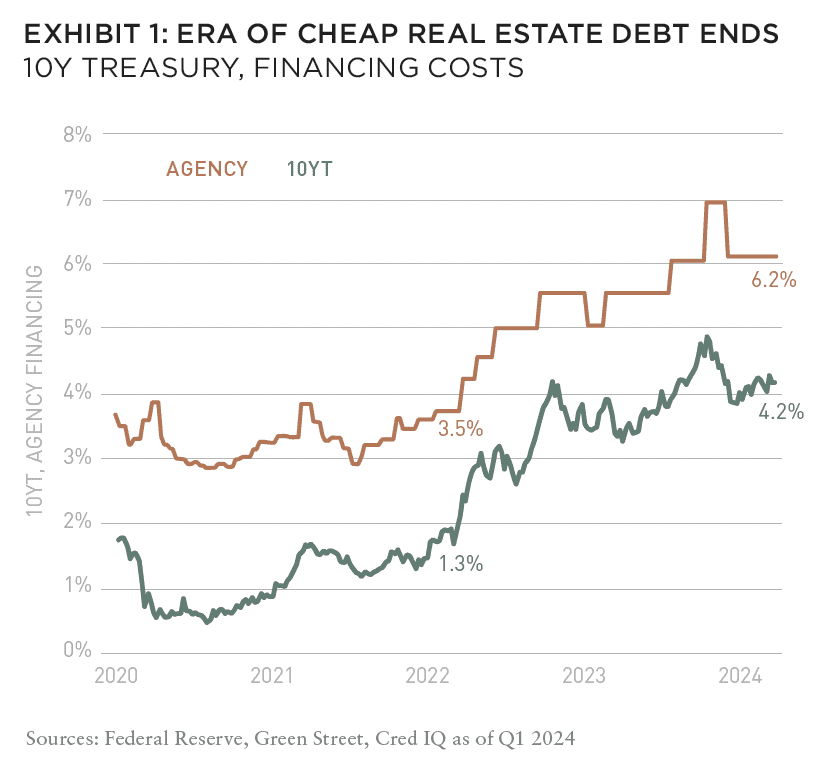
Even then, many recognized that the pace of sales activity was unsustainable, with many describing it as an investor “feeding frenzy” fueled by cheap leverage. At the time, the 10-year Treasury yielded around 1.3% and all-in debt costs for stabilized multifamily were between 3% and 4% using government-sponsored entities (GSE) pricing as a proxy.2
In the first quarter of 2022, the US Federal Reserve embarked on a monetary tightening campaign, ending what effectively had been a golden period from the end of 2009 to the end of 2021, when 10-year Treasuries declined from approximately 3.5% to 1.3% and Sunbelt apartment cap rates declined from 7.5% to 4.5%.3
The change in monetary policy resulted in a sharp decline in transactional liquidity over the following two years as base rates and financing costs rose by approximately 300 basis points, making most debt dilutive at best and generally unattainable without a meaningful paydown from a sponsor looking to refinance (Exhibit 1). Subsequent stress in regional banks further compounded market liquidity challenges.
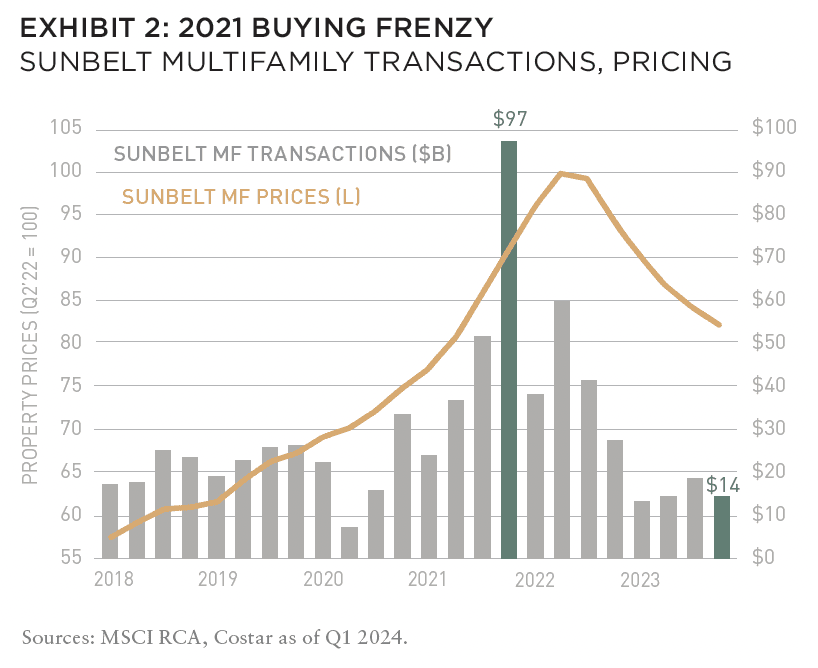
By the end of the first quarter this year, Sunbelt multifamily trades had declined to $14 billion. The pullback in transactional activity over the past two years also has driven a decline of 18% in unlevered property value from its peak in the second quarter of 2022 (Exhibit 2).
Since the peak, cap rates have risen from 4.5% to 5.7% (as of Q1 2024), equating to a 21% decline in value if net operating income (NOI) had remained constant. But NOI has not remained constant over the period. Instead, rental revenues have fallen on average by approximately 7% (Exhibit 3), which may not seem like much except that when buyers transact at peak pricing, they do not anticipate declining rental revenues as their base case.
WHERE WE ARE NOW
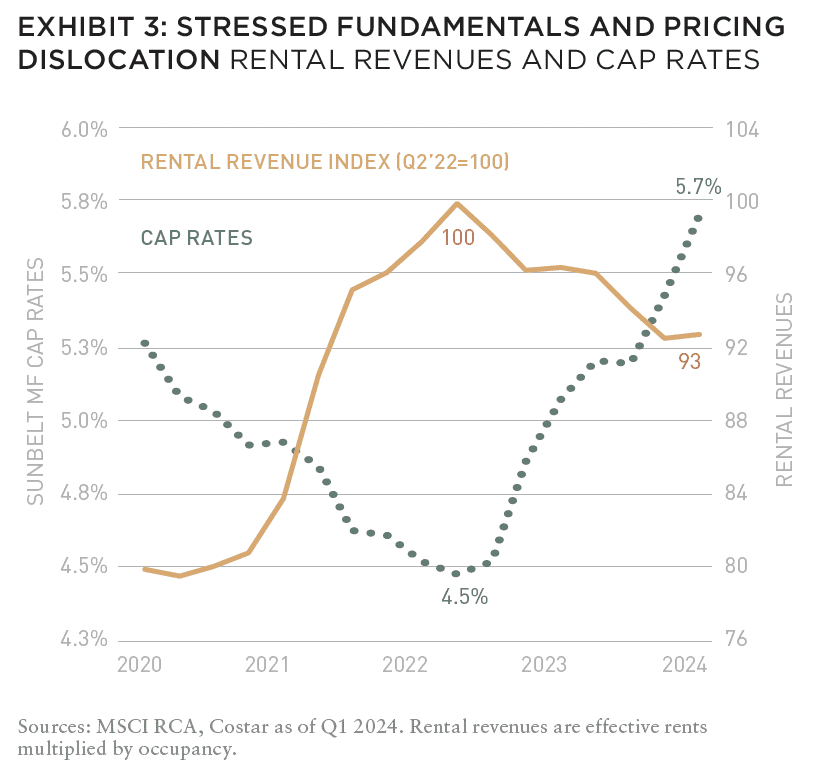
Clearly, many recent buyers and developers of Sunbelt multifamily properties are overleveraged and sit atop capital stacks that must be reconfigured.
In many cases, additional capital is needed to bridge the yawning funding gap between what developers owe and the significantly depreciated equity value of their properties. In other cases, time has run out; distress events in the form of foreclosures, discounted payoffs, and other drastic actions are imminent absent loan modifications, which are difficult to come by as underwriting standards have tightened. Looming ahead are an estimated $120 billion in Sunbelt multifamily commercial mortgages scheduled to mature through 2027.4
Currently, on commercial real estate collateralized loan obligations (CRE CLO) collateralized by multifamily properties, delinquency rates have jumped to 11.1% (Exhibit 4). Unlike CMBS, loans in CRE CLO pools are made primarily on transitional assets. That means there is usually a specific business plan justification making these loans riskier than those on stabilized properties.
Capital stacks associated with strategies in which pricing is amplified by disruptions to the project timeline face greater urgency for a capital infusion, than do stabilized properties with diminished but sufficient cashflow.
STRUCTURAL DEMAND DRIVERS STILL INTACT
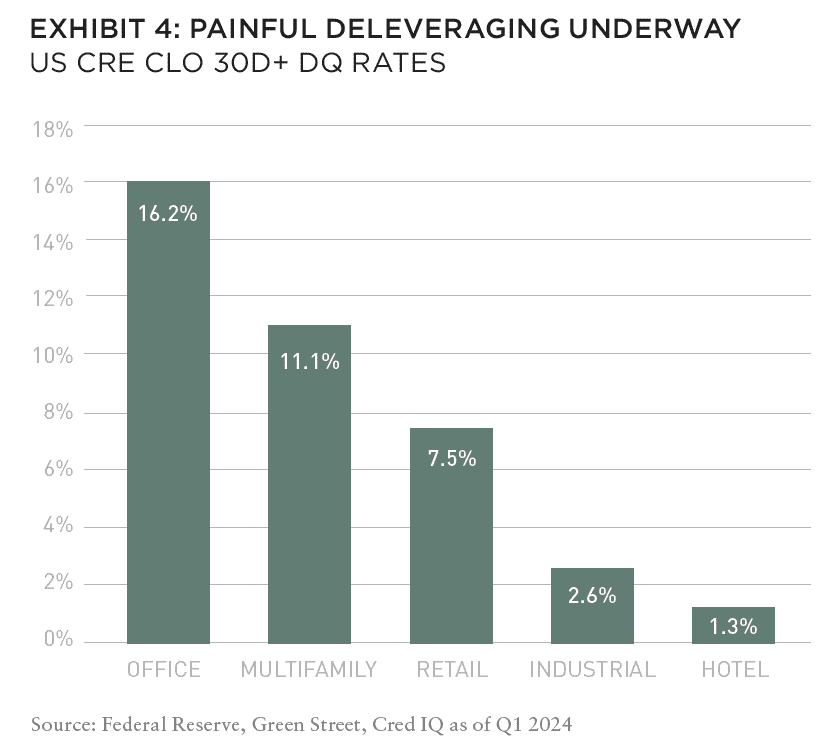
Despite the gloom—which has been compounded by record levels of new construction that have caused occupancy rates to drop and rents to flatten and even decline—there are reasons for investors with “patient capital” to consider the sector.
Sunbelt demand growth, driven by ongoing demographic tailwinds, will likely continue to lead the rest of the US over the next five years.
Additionally, Sunbelt states offer favorable business environments, lower operating costs, and less stringent regulations. These spur business relocations and the expansion of existing facilities, creating a positive feedback loop of population and employment growth.
Over the medium term, therefore, the outlook for multifamily Sunbelt properties looks brighter than what today’s prevailing gloom would suggest.
While valuations have not yet stabilized, a cyclical bottom and eventual recovery are closer now than they were two years ago when the current downturn began. Preqin estimates that $250 billion in dry powder was available for US real estate investment in May 2024, and much of it has been there for some time.
With capital so much in demand, patient investors with a keen eye for value and a willingness to stand apart from the crowd may be able to capitalize on potential opportunities in this sector.
EXPLORE THE NEW ISSUE
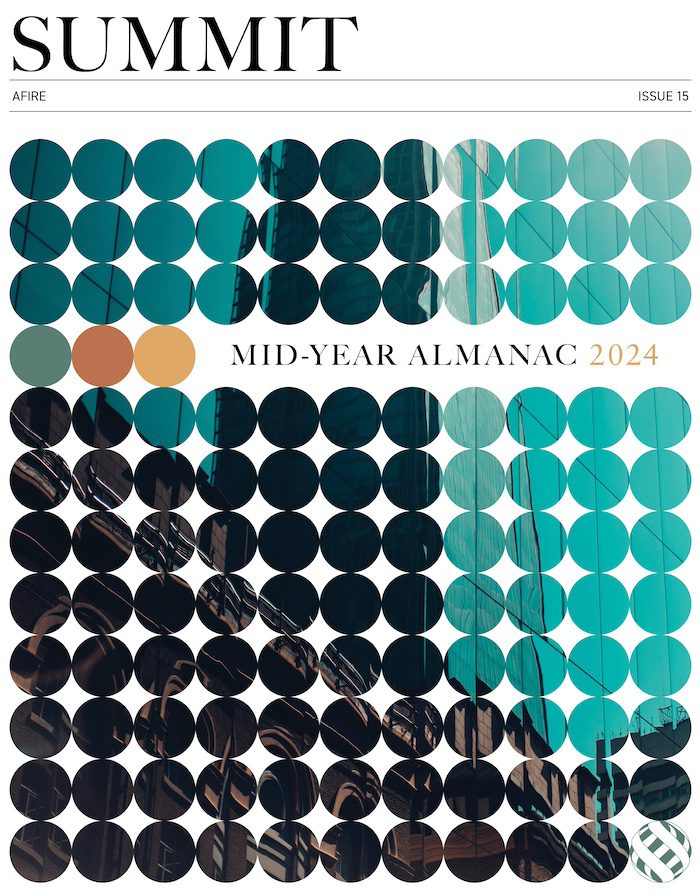
NOTE FROM THE EDITOR: WELCOME TO #15
Benjamin van Loon | AFIRE
MID-YEAR CRE MARKET OUTLOOK: AFIRE
Benjamin van Loon and Gunnar Branson | AFIRE
MULTIFAMILY OUTLOOK: AMERICAN REALTY ADVISORS
Sabrina Unger and Britteni Lupe | American Realty Advisors
MULTIFAMILY GAP CAPITAL: BARINGS REAL ESTATE
Dags Chen, CFA and Lincoln Janes, CFA | Barings Real Estate
SINGLE-FAMILY RENTAL OUTLOOK: CERBERUS CAPITAL MANAGEMENT
Kevin Harrell | Cerberus Capital Management
SINGLE-FAMILY RENTAL SUPPLEMENT: YARDI
Paul Fiorilla | Yardi
LOGISTICS OUTLOOK: BRIDGE INVESTMENT GROUP
Jay Cornforth, Jack Robinson, PhD, Morgan Zollinger, and Cole Nukaya | Bridge Investment Group
DATA CENTER OUTLOOK: PRINCIPAL ASSET MANAGEMENT
Casey Miller and Ben Wobschall | Principal Asset Management
SELF-STORAGE OUTLOOK: HEITMAN
Zubaer Mahboob | Heitman Europe
COLD-STORAGE OUTLOOK: NEWMARK
Lisa DeNight | Newmark
OFFICE OUTLOOK: CUSHMAN & WAKEFIELD
David Smith | Cushman & Wakefield
RETAIL OUTLOOK: MADISON INTERNATIONAL REALTY
Christopher Muoio | Madison International Realty
HOSPITALITY OUTLOOK: JLL
Zach Demuth | JLL
+ LATEST ISSUE
+ ALL ARTICLES
+ PAST ISSUES
+ LEADERSHIP
+ POLICIES
+ GUIDELINES
+ MEDIA KIT (PDF)
+ CONTACT

—
NOTES
1. MSCI Real Capital Analytics; as of Q1 2024.
2. Federal Reserve, Green Street, Cred IQ; as of Q1 2024.
3. MSCI RCA, Costar; as of Q1 2024.
4. MSCI RCA, Cushman Wakefield; as of Q4 2023.
—
ABOUT THE AUTHORS
Dags Chen is Managing Director and Head of US Real Estate Research and Strategy, and Lincoln Janes, CFA, is Director of US Real Estate Research and Strategy for Barings Real Estate, one of the world’s largest diversified real estate investment managers, with $48.18 billion AUM, offering a broad spectrum of solutions across private real estate debt and equity.
—
THIS ISSUE OF SUMMIT JOURNAL IS GENEROUSLY SPONSORED BY

Founded in 1992, Cerberus is a global leader in alternative investing with approximately $65 billion1 in assets across complementary credit, private equity, and real estate strategies. We invest across the capital structure where our integrated investment platforms and proprietary operating capabilities create an edge to improve performance and drive long-term value. Learn more.

Principal Real Estate is the dedicated real estate investment team of Principal Asset Management, the global investment solutions business for Principal Financial Group®. As a top 10 global real estate manager, with over $98 billion in assets under management and more than 60 years of experience, we provide clients with access to opportunities across both public and private equity and debt. Learn more.

